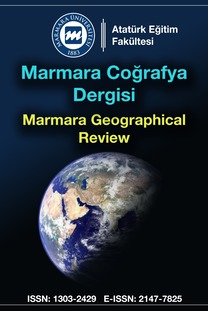Fransa’da coğrafya ders kitaplarında fiziki coğrafya konularının işlenişi, uygulanan alıştırmalar, etkinlikler ve özellikleri
Fransa coğrafya ders kitaplarında ilk dikkat çeken özelliklerden biri konular fiziki, beşeri ve ekonomik coğrafya olarak ayrı bir sınıflandırmaya gidilmemiştir. Fiziki coğrafya konuları büyük ölçüde insan boyutuyla ele alınmaktadır. İnsanın içinde olmadığı, rol oynamadığı bir coğrafyanın tam olarak coğrafyayı yansıtmadığı düşünülmektedir. Konular işlenirken ağır, ezbere dayalı bir fiziki coğrafya terminolojisi kullanılmazken ilgili terimlerin kısa bir şekilde tanımı yapılmamaktadır. Örneğin, kıyılar konusu işlenirken kıyıların oluşumu, kıyı türlerinden ziyade kıyılardaki kirlilik, nüfuslanma, kıyılardaki ticaret ve turizm faaliyetleri, kıyılarda sürdürülebilir gelişme ve önemli limanlar gibi açılardan ele alınmaktadır. Fiziki coğrafya konuları diğer konularda olduğu gibi etkinlik ve alıştırma çalışmalarıyla desteklenmiştir. Bu çalışmalarda genellikle öğrencilerden ilgili konuyu verilen metinlerden incelemeleri, analiz ve sentez yapmaları ve daha sonra bir sonuca ulaşarak ortaya çözüm önerileri koymaları istenmektedir. Çalışmalarda öğrencilerin dilsiz bir harita üzerinde konuyla ilgili bir lejant oluşturmaları ve lejantta yer alan bilgilerin haritalarda göstermeleri istenmektedir. Bu tür çalışmalar her konu içerisinde yer bulmuştur.
(Treating the Physical Geography subjects with exercises, activities, features in Geography Textbooks in France)
In Geograhpy Textbook in France there is no strict classification between Physical, Human, Economic Geography and this is one of the striking features of the textbooks. Physical geography subjects are dealt with human aspect and role. It is considered that without human aspect geography doesn’t exactly reflect its nature. Heavy geographic terminology isn’t used while treating a geography subject and related terminology given in a box in the page. For instance, treating the subject of coasts, the evolution of coasts and coast types are thought beyond the scope of the subject and coastal pollution, and coastal commerce and tourism, sustaninable development, dense settlements in coasts are the main aspects while handling the subject. Physical geography subjects in textbooks supported with exercises and activities. In these exercises, it is wanted for students to examine, analyse, synthesise the related passages and then reach a conclusion by giving possible solutions and suggestions to the subject involved. In the last part of the exercises a blank map given to students to fill in it properly with the help of a legend that constructed by students. These kinds of exercises can be found in every subject in geography textbooks.
___
Baboun, A., D., Balby, Bidron, J., H., Chemin, A., Gasnier, A., Gaudin, C., Joyeux, A. Martinez, G., Prost, F. (2006). Géograhie 2. Hachette Education, Paris, S. 242-245.Baud, P., Bougeat, S., Bras, C. (2008). Dictionnaire de Géographie, 4. Edition Hatier, Paris.
Bénichi, R., Champigny, D., Girotto, D., Marseille, J., Scheibling, J. (1999).
Bilgili, M. (2011). Basılmamış Doktora Tezi, Fransa’da İlk Ve Orta Dereceli Okullarda Coğrafya Eğitim Ve Öğretiminin Müfredat, Metot ve Araç-Gereçler Açısından Değerlendirilmesi, S.227.
Eduscol (2010). L’étude de cas en géographie – classe de seconde, http://media.eduscol.education.fr/file/lycee/74/1/LyceeGT_R essources_HGEC_2_Geo_02_EtudCasGeo_148741.pdf, internet adresinden 22.10.2011 tarihinde alınmıştır.
Eduscol (2010). Question au choix: L’eau, ressource essentielle, http://media.eduscol.education.fr/file/lycee/74/7/LyceeGT_R essources_HGEC_2_Geo_05_T2EauRess_148747.pdf, internet adresinden 14.10.2010 tarihinde alınmıştır.
Eduscol (2010). Question obligatoire: Du développement au développement durable, http://media.eduscol.education.fr/ file/lycee/74/3/LyceeGT_Ressources_HGEC_2_Geo_03_Tin troEnjxDvptDur_148743.pdf, internet adresinden 22.10.2011 tarihinde alınmıştır.
Géographie 3. Le monde d’aujourd’hui. Nathan Edition, Paris. S. 245- 248.
Mayhew, S. (2004). Oxford Dictionary of Geography, Oxford University Press, Third Edition, 221-222.
Ministère de l'Éducation nationale, Les niveaux et les établissements d'enseignement http://www.education.gouv.fr/cid213/l-ecoleelementaire- organisation-programme-et-fonctionnement.html internet adresinden 20.07.2011 tarihinde alınmıştır.
Ministère de l'Éducation nationale, Décentralisation et enseignement – dossiers documentaires - https://mentor.adc.education.fr , internet adresinden 23.07.2011 tarihinde alınmıştır.
Ministère de l'Éducation nationale, Eduscol (2010). Le développement durable, fil conducteur du programme de géographie de seconde, http://media.eduscol.education.fr/file/lycee/73/9/LyceeGT_R essources_HGEC_2_Geo_01_DvptDur_FilConducteur_1487 39.pdf, internet adresinden 27.10.2011 tarihinde alınmıştır.
Ministère de l'Éducation nationale, Eduscol (2010). Histoire-géographieéducation civique-ECJS, http://eduscol.education.fr/ cid52286/ressources-pour-la-classe-de-seconde.html
Ministère de l'Éducation nationale, Eduscol (2010). Grilles de références pour l'évaluation et la validation des compétences, Socle Commun, http://eduscol.education.fr/cid53126/grilles-dereferences- socle-commun.html, internet adresinden 24. 10.2011 tarihinde alınmıştır.
- ISSN: 1303-2429
- Yayın Aralığı: Yılda 2 Sayı
- Başlangıç: 1997
- Yayıncı: Marmara Üniversitesi
Sayıdaki Diğer Makaleler
Coğrafya eğitiminde bölge kavramı
Ulaşım coğrafyası açısından Türkiye’de havayolu ulaşımının tarihsel gelişimi ve mevcut yapısı
Çarşamba Çayı’nın 15 aralık 2010 tarihli taşkını ve Bozkır’daki (Konya) etkisi
Adnan Doğan BULDUR, Sabahattin SARI
Atatürk Dönemi (1923–1938) ilkokullarda coğrafya eğitimi
Bosna – Hersek Cumhuriyeti’nde coğrafyanın halk kültürüne etkisi
Afyonkarahisar ilinde jeotermal enerji kullanımı ve sorunları
Ekoloji Temelli Doğa eğitimi projelerinin katılımcı beklentilerini karşılama düzeyleri
ALİ MEYDAN, RECEP BOZYİĞİT, Musa KARAKURT
Uzaktan algılama teknolojileri ile beykoz ilçesi (1986-2011) arazi kullanımı değişim analizi
Kırsal kalkınma açısından ayrancı Ovası ve yakın çevresi (Banaz) doğal kaynakları
